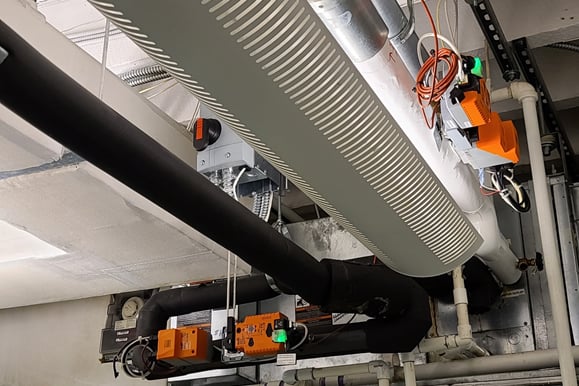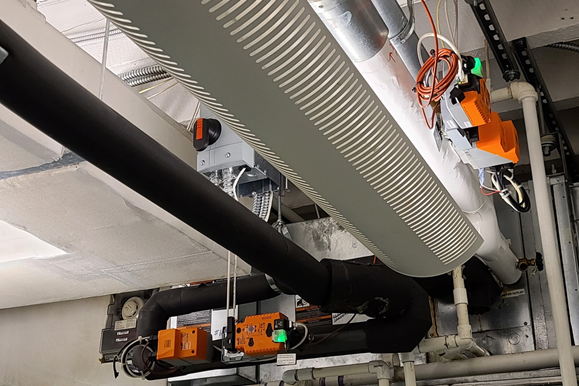Berkeley County, West Virginia Cut HVAC Energy Usage in Half
For nearly four decades, the Dunn Building in Berkeley County, West Virginia, operated as a woolen sock mill. Since then, it has been used for various purposes, including a shopping center and technical college. Today, it serves as administrative offices for Berkeley County.
Since taking sole ownership, Berkeley County officials have initiated multiple capital improvement projects to lower costs and increase energy efficiency. The most recent upgrade took place in 2019 when the county contracted Maryland-based Boland Trane to perform a complete overhaul of the building's heating and cooling systems. For the project, Boland replaced several outdated system components with state-of-the-art energy-conserving technologies – one of which was the Belimo Energy Valve™.
The primary motivation for the upgrade project was to decrease HVAC energy consumption and cost and improve occupant comfort. Boland Trane's solution for achieving these goals was two-fold. The first objective was to improve the efficiency of the production of hot and chilled water. The second was to optimize the utilization to meet the building's heating and cooling load.
Boland Trane replaced four 1.7 million BTU hot water boilers installed in the 1970s to address the production of hot water with one 6 million BTU high-efficiency modular boiler. Also installed for cooling was a new 250 ton air-cooled Trane helical rotary chiller, along with an ice plant and associated storage.
Although the previous chiller was only 12 years old, it was in a state of disrepair – with half of its compressor modules inoperable. Despite its condition, a system evaluation revealed that it was not the primary root cause of the building's poor performance. Like many older facilities, the Dunn Building suffered from low Delta T syndrome (i.e., inefficient heat transfer across coils) caused by over pumping of the chilled water system. This contributed to the short cycling of the chiller's compressors. It also increased the building's electricity usage. To maximize energy efficiency and prevent the new chiller from meeting the same fate as the old one, Berkley County and Boland Trane determined that additional system upgrades would have to be made beyond installing the new boilers and chiller plant. More specifically, the low Delta T problem needed to be addressed. For this, they turned to the Belimo Energy Valve.

Eighty-seven Energy Valves were installed throughout the Dunn Building; forty-two each on both the heating and cooling coils in FCU and 3 on the cooling coils in existing AHU. During commissioning, the built-in diagnostic capabilities of the valves indicated that a flow problem existed. It was first suspected that the valves were installed backwards. After further evaluation, the supply and return lines to a number of air handlers were incorrectly piped.
"The Energy Valve revealed a critical flaw in the building's cooling system, the supply and return line risers had been mislabeled and thus incorrectly installed on roughly a third of the building's air handlers", said Jim Bauer, Account Executive at Boland Trane. "This mistake from the previous contractor occurred nearly 12 years prior to the upgrade project and was significantly hindering the building's efficiency and performance. Had we not installed the Energy Valves, it is unlikely the problem would have been discovered."

The Energy Valves had an immediate impact on the cooling efficiency of the building. Delta T across the coils increased by an average of 8°F (from 4 to 12°F). By correcting the coils' flow and operating them at design specifications, the valves eliminated over-pumping. Boland Trane also installed variable frequency drives (VFDs) on all air handlers and fan coil units to enable single-zone variable air volume (VAV) control. Together with the ice plant and storage installation, these upgrades resulted in a 50% reduction in the Dunn Building's energy usage. The Energy Star rating of the building also increased by 19 points – from 74 to 93.
In addition to the energy-saving benefits, the Energy Valve diagnostic and data gathering capabilities provide visibility into building performance down to the individual fan coils and air handlers. All of the valves' data and the Building Automation Systems (BMS) are added to the Applied Building Insights Platform. The insights identify opportunities for efficiency improvements and continuous optimization every quarter.
The Energy Valve has been added to Boland Trane’s Top-5 list of energy conservation measures (ECM).

